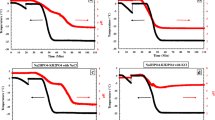Abstract
Solubilization of pepsin by bis(2-ethylhexyl) sodium sulfosuccinate (AOT) and cetyltrimethylammonium bromide (CTAB) reverse micelles has been studied at 20∘C. Isooctane, cyclohexane and hexane were used as solvents, and n-butanol, amyl alcohol and hexanol were used as cosurfactants for CTAB. AOT concentrations were varied from 50 to 500 mM and pepsin concentrations were varied from 2 to 10 mg-mL−1. At 250 mM, AOT can solubilize more than 85% of the Pepsin in each solvent. The effect of aqueous-phase pH on the solubilization of Pepsin has been studied from pH 1 to 8. The maximum solubilization of pepsin was observed below the isoelectric point (pI = 1.5) of the protein at pH 1.0 with 300 mM of AOT. The CTAB solutions were prepared by dissolving CTAB in isooctane with varying concentrations (0–100% v/v) of n-butanol, amyl alcohol or hexanol cosurfactants. It was found that 5% cosurfactant with 100 mM of CTAB was sufficient to solubilize more than 90% of the total pepsin. Pepsin solubilization by AOT reverse micelles increases with increasing polarizability and molar volume of the solvents.
Similar content being viewed by others
References
T. A. Hatton and J. F. Harewell (Ed.), Surfactant-based Separation Processes, (Marcel Dekker, New York, 1989) p. 55.
K. Martinek, A. V. Levashov, N. Klyachko, Y. L. Khelnitri, and L. V. Berezin, Eur. J. Biochem. 155, 453 (1986).
P. L. Luisi, M. Giocomini, M. P. Pieline, and B. H. Robinson, Biochim. Biophys. Acta 947, 209 (1988).
Q. Chang, J. Chem. Biotech. Bioeng. 46, 172 (1995).
Q. Chang, J. Chen, and L. Huizhou, Enzyme Microbiob. Tech. 16, 970 (1994).
G. A. Krei and H. Husted, Chem. Eng. Sci. 47, 99 (1992).
N. L. Abbot and T. A. Hatton, Chem. Eng. Progress 31 (1988).
O. H. Lowery, N. J. Rosenbrough, A. J. Farr, and R. J. Randall, J. Biol. Chem. 193, 265 (1951).
Q. Lu, C. Hongyan, L. Kuanhong, and S. Yajun, Biochem. Eng. J. 145, 45 (1998).
M. Dekker, R. Hilhorst, and C. Laane, Anal. Biochem. 178, 217 (1989).
H. R. Rabie and J. H. Vera, Ind. Eng. Chem. Res. 35, 3665 (1996).
E. B. Leodidis and T. A. Hatton, J. Phys. Chem. 94, 6400 (1990).
D. H. Logdail and M. J. Slater (Ed), Solvent Extraction in the Process Industries, Vol. 2, (Elsevier, London, 1993).
M. Zulauf and H. F. Eicke, J. Phys. Chem. 83, 480 (1979).
C. A. Martin and L. J. Magid, J. Phys. Chem. 85, 3938 (1981).
M. Wong, J. K. Thomas, and M. Gratzel, J. Am. Chem. Soc. 98, 2391 (1976).
E. M. Kosower, An Introduction to Physical Organic Chemistry, (Wiley, New York, 1968).
M. J. Kamlet, J. L. Abbound, and R. Taft, J. Am. Chem. Soc. 99, 6027 (1977).
A. Grei and H. Hustedt, Chem. Eng. Sci. 47, 99 (1992).
Author information
Authors and Affiliations
Corresponding author
Rights and permissions
About this article
Cite this article
Sivasamy, A., Rasoanto, P.I., Ramabrahmam, B.V. et al. Effects of Nonpolar Solvents on the Solubilization of Pepsin into Bis(2-Ethylhexyl) Sodium Sulfosuccinate and Cetyltrimethylammonium Bromide Reverse Micelles. J Solution Chem 34, 33–42 (2005). https://doi.org/10.1007/s10953-005-2066-z
Received:
Revised:
Issue Date:
DOI: https://doi.org/10.1007/s10953-005-2066-z




